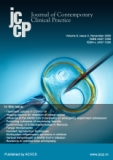Epidemiology of extended-spectrum β-lactamases and carbapenemases producing Enterobacteriaceae in Morocco
Epidemiology of extended-spectrum β-lactamases and carbapenemases producing Enterobacteriaceae in Morocco
Author(s): Samira Natoubi, Abouddihaj Barguigua, Idrissa Diawara, Mohammed Timinouni, Khalid Rakib, Souad Amghar, Khalid ZeroualiSubject(s): Higher Education , Health and medicine and law, Present Times (2010 - today)
Published by: Asociația pentru Creșterea Vizibilității Cercetării Științifice (ACVCS)
Keywords: Carbapenemase; Enterobacteriaceae; ESBL; risk factors;
Summary/Abstract: Introduction The objectives of the study were to report the prevalence as well as the characteristics of the extended-spectrum β-lactamases (ESBL) and carbapenemases producing Enterobacteriaceae isolated from patients in provincial Hospital Hassan II in Settat-Morocco. Methods From January 2012 to December 2014, non-duplicate 183 strains of Enterobacteriaceae were isolated from hospitalized patients. Resistance genes were characterized by polymerase chain reaction with specific primers for ESBL, carbapenemases and AmpC cephalosporinases. PCR products of ESBL genes were sequenced. The molecular epidemiology was investigated using pulsed field gel electrophoresis (PFGE). Results The overall prevalence of ESBL producing Enterobacteriaceae (ESBL-E) was 24.59% (45/183), among these, 44.4% (n=20) were Klebsiella pneumoniae, 42.2% (n=19) were Escherichia coli, 11.1% (n=5) were Enterobacter cloacae and 2.2% (n=1) were Morganella morganii. The most frequent ESBL genes were blaCTXM-15 (35/45; 77.8%). Plasmid mediated Amp-C β-lactamases DHA-1 was found in one E. cloacae. The prevalence of carbapenemases producing Enterobacteriaceae (CPE) isolates was 5.46% (10/183) and all these CPE isolates were found to carry the blaOXA-48 gene. Previously hospitalization, diabetes mellitus, urinary tract infection, central venous catheter and mechanical ventilation were found as significant risk factors. PFGE typing for carbapenemase producing strains revealed five pulsotypes for K. pneumoniae and three for E. cloacae. Conclusions Our data have shown a high frequency of ESBL and CPE with the emergence of CTX-M-15 and OXA-48 producers. This remarkable increase at the provincial hospital Hassan II in Settat urges us to opt for specific strategies for regular surveillance.
Journal: Journal of Contemporary Clinical Practice
- Issue Year: 6/2020
- Issue No: 2
- Page Range: 75-85
- Page Count: 11
- Language: English

